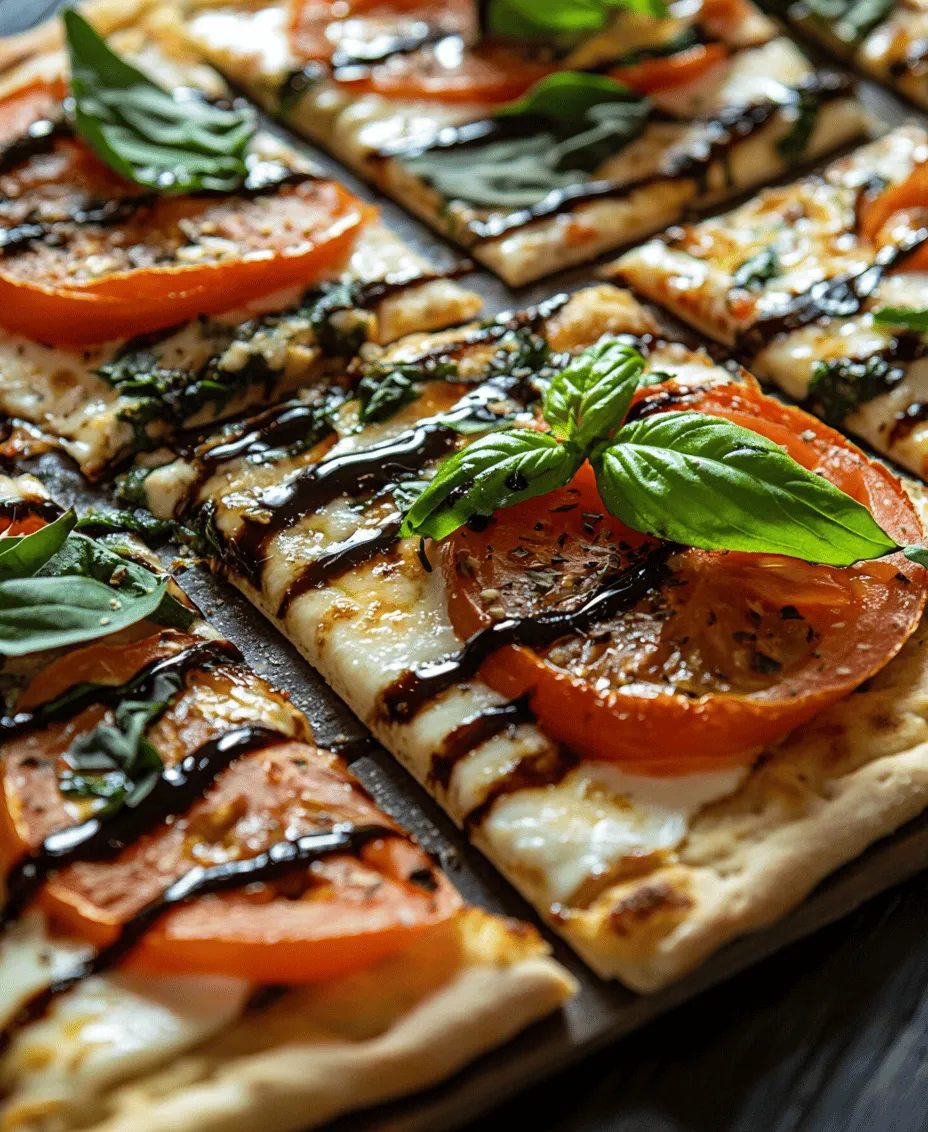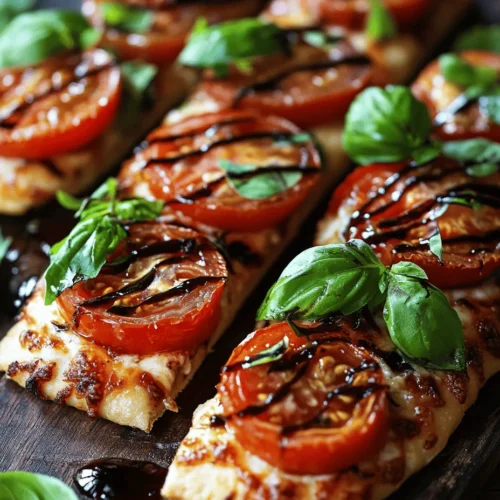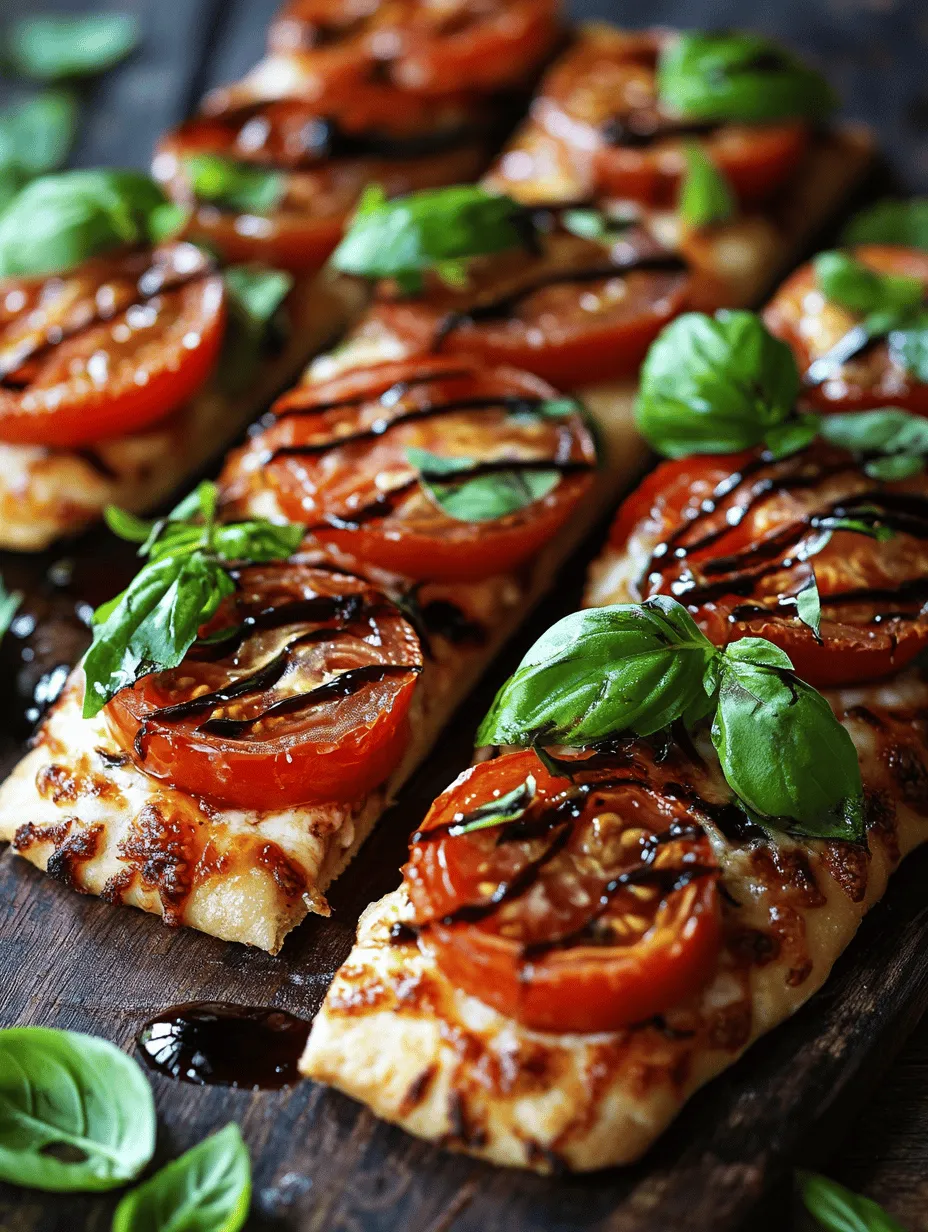Discover the delightful simplicity of Classic Margherita Flatbread Pizza, a dish that celebrates fresh ingredients and vibrant flavors. Originating from Naples, Italy, this iconic pizza embodies the principles of Italian cuisine—simplicity, quality, and a focus on seasonal ingredients. Margherita pizza is not just a meal; it’s a culinary experience that brings the essence of Italy to your dining table. With its crispy base, gooey cheese, and fragrant basil, it is a dish that is both comforting and sophisticated.
Whether you’re hosting a casual gathering with friends or simply indulging in a comforting meal at home, this flatbread pizza is sure to impress. It can be whipped up in no time and is adaptable to various dietary preferences. In this article, we will explore the essential ingredients that make this dish shine, provide detailed preparation steps, and share the cooking process, ensuring that you can recreate this classic in your own kitchen.
Understanding the Ingredients: A Closer Look at Margherita Flatbread Pizza
To create the perfect Classic Margherita Flatbread Pizza, it’s crucial to understand the role of each ingredient in crafting a dish that is both delicious and authentic. Let’s delve into the essential components that make this pizza so special.
Flatbread: The Foundation of Flavor
At the heart of any good flatbread pizza is, of course, the flatbread itself. Whether you choose store-bought or homemade flatbread, it serves as the base that holds all the delicious toppings together. The ideal flatbread for Margherita pizza should be thin and crisp, allowing for a delightful crunch with each bite. Homemade flatbread can be made with just a few simple ingredients, including flour, water, and salt, making it a versatile option for those who enjoy baking.
Olive Oil: Enhancing Richness and Texture
Olive oil is a cornerstone of Mediterranean cooking and plays a vital role in enhancing the richness and texture of your flatbread pizza. A quality extra virgin olive oil not only adds flavor but also helps to achieve a golden, crispy crust. Drizzling olive oil over the flatbread before baking ensures that it cooks evenly, while also infusing the pizza with a subtle fruitiness that complements the other ingredients.
Fresh Mozzarella Cheese: Creaminess and Authenticity
When it comes to cheese for a classic Margherita pizza, fresh mozzarella is a non-negotiable ingredient. Known for its creamy texture and mild flavor, fresh mozzarella melts beautifully, creating that iconic stretchy cheese effect. Look for mozzarella di bufala (buffalo mozzarella) for an authentic taste, or opt for cow’s milk mozzarella if that’s what you have on hand. Either way, ensure it’s fresh and of high quality for the best results.
Tomatoes: The Heart of the Dish
Tomatoes are the soul of a Margherita pizza. For this recipe, you can use fresh, ripe tomatoes or canned San Marzano tomatoes, which are renowned for their sweetness and low acidity. If using fresh tomatoes, slice them thinly to allow them to cook evenly on the flatbread. For a sauce-like texture, you can crush the canned tomatoes with a fork, adding a sprinkle of salt to enhance their natural sweetness. The key is to let the tomato flavor shine through without overwhelming the other ingredients.
Fresh Basil: Aromatic and Flavorful Garnish
Fresh basil is the finishing touch that elevates the flavors of the Classic Margherita Flatbread Pizza. With its aromatic notes and vibrant green color, basil not only adds visual appeal but also provides a fresh, herbal contrast to the rich mozzarella and sweet tomatoes. Be sure to use whole leaves or tear them gently to release their essential oils, enhancing the overall flavor of the dish.
Sea Salt and Black Pepper: Seasoning for Perfection
Seasoning is essential for bringing out the flavors of your ingredients. A sprinkle of sea salt and freshly cracked black pepper will enhance the sweetness of the tomatoes and the creaminess of the mozzarella. Use high-quality sea salt for a touch of minerality, and adjust the seasoning to your preference.
Optional Balsamic Glaze: Adding a Sweet Touch
While not traditional, a drizzle of balsamic glaze can add a sweet and tangy element that complements the other flavors beautifully. This optional ingredient is perfect for those who enjoy a hint of sweetness on their pizza. You can either purchase balsamic glaze or make your own by reducing balsamic vinegar until it thickens.
Preparation Steps: Crafting Your Classic Margherita Flatbread Pizza
Now that we’ve explored the essential ingredients, it’s time to focus on the preparation steps that will set you up for success in crafting your Classic Margherita Flatbread Pizza. Follow these detailed instructions to ensure a delicious outcome every time.
Preheating the Oven: The Importance of Temperature
Before you begin assembling your flatbread pizza, it’s essential to preheat your oven. For optimal results, set your oven to 475°F (245°C). A hot oven is crucial for achieving a crispy crust while ensuring the cheese melts beautifully. If you have a pizza stone, place it in the oven while it preheats; this will help create a nice, even heat that mimics a traditional pizza oven.
Preparing the Flatbread: Ensuring a Crisp Base
If you’re using store-bought flatbread, simply lay it out on a baking sheet lined with parchment paper. If you’re making homemade flatbread, roll out the dough to your desired thickness, typically around 1/4 inch. You can also brush the flatbread lightly with olive oil before baking it to enhance the crispiness. This step is particularly important if you’re using a thicker flatbread, as it helps to create a barrier against moisture from the toppings.
Layering the Ingredients: Artful Assembly for Flavor
Once your flatbread is ready, it’s time to layer the ingredients. Start by spreading a thin layer of your crushed tomatoes or sliced fresh tomatoes across the flatbread, leaving a small border around the edges. The key is to avoid overloading the pizza, as excess moisture can lead to a soggy crust. Next, tear or slice your fresh mozzarella and distribute it evenly over the tomatoes. Finish with a generous sprinkle of fresh basil leaves, reserving a few for garnish after baking.
Baking the Pizza: Achieving the Perfect Finish
With your flatbread pizza assembled, it’s time to slide it into the preheated oven. Bake for approximately 10-12 minutes, keeping an eye on it to ensure it doesn’t overcook. You’re looking for a golden-brown crust and bubbling cheese. If you’re using a pizza stone, you might find that the pizza cooks a bit faster, so check it a few minutes early to avoid burning.
Finishing Touches: Adding Freshness and Flavor
As soon as your Classic Margherita Flatbread Pizza comes out of the oven, it’s time for the finishing touches. Drizzle a bit of high-quality extra virgin olive oil over the top for added richness. You can also sprinkle a pinch of sea salt and freshly cracked black pepper for an extra flavor boost. Finally, add the reserved fresh basil leaves for a pop of color and an aromatic finish that enhances the overall presentation of your pizza.
The Cooking Process: Step-by-Step Instructions for Perfect Pizza
Now that you are familiar with the preparation steps, let’s break down the cooking process into clear, actionable steps to guide you in making your Classic Margherita Flatbread Pizza.
– Preheat the Oven to 475°F (245°C): Ensure your oven is fully preheated to achieve that crispy, golden crust.
– Brush Flatbread with Olive Oil: Lightly coat the flatbread with olive oil to promote crispiness and flavor.
By following these steps, you’ll be well on your way to enjoying a delicious Classic Margherita Flatbread Pizza that showcases the beauty and simplicity of Italian cuisine. Continue to the next section for a more detailed walkthrough of the cooking process, ensuring that every aspect of your pizza is executed flawlessly.

Distributing Fresh Mozzarella Evenly
Once your flatbread base is ready, it’s time to layer on the fresh mozzarella. This cheese is the star of the show, providing a creamy texture that complements the other ingredients beautifully. Begin by tearing the mozzarella into small, bite-sized pieces. This approach not only ensures even melting but also allows the cheese to create those delightful, gooey pockets that we all love.
Distribute the mozzarella evenly across the flatbread, keeping in mind that the cheese will expand and bubble as it bakes. Aim for a balanced coverage; you want every slice to have its fair share of cheese without overwhelming the flatbread. The optimal amount is about 8 ounces for a standard flatbread, but feel free to adjust based on your personal preference for cheesiness.
Arranging Tomato Slices for Visual Appeal
Next, it’s time to add the tomatoes. Using fresh, ripe tomatoes is critical for achieving the vibrant flavor profile that defines a Margherita pizza. Roma or vine-ripened tomatoes work particularly well due to their firm texture and rich taste. Slice the tomatoes into thin rounds, about 1/4 inch thick, to allow for even cooking.
Arrange the tomato slices in a visually appealing manner on top of the mozzarella. You can create a simple overlapping pattern or a circular design that radiates from the center. Not only does this enhance the visual appeal of your flatbread pizza, but it also ensures that each bite is a harmonious blend of flavors, combining the creaminess of the mozzarella with the acidity of the tomatoes.
Seasoning with Sea Salt and Black Pepper
To elevate the flavors further, season your pizza with a sprinkle of sea salt and freshly cracked black pepper. The salt will enhance the natural sweetness of the tomatoes and the creaminess of the mozzarella, while the black pepper adds a hint of spice. Be careful not to overdo it; a light touch is all you need to bring out the best in your ingredients.
Additionally, you can consider adding a dash of dried oregano or Italian seasoning for an extra layer of flavor. These herbs will complement the fresh basil you’ll add later, tying the entire dish together beautifully.
Baking to Golden Perfection: Timing and Techniques
With your ingredients beautifully arranged, it’s time to bake your flatbread pizza. Preheat your oven to 475°F (245°C) – this high temperature is key to achieving that crispy, golden crust. If you have a pizza stone, place it in the oven while it preheats; this will help distribute heat evenly and create a perfectly crisp base.
Place the flatbread pizza on a baking sheet or directly onto the hot pizza stone. Bake for about 10-12 minutes, or until the cheese is bubbling and golden brown, and the edges of the flatbread are crisp. Keep an eye on it towards the end of the baking time to prevent burning. If you prefer a slightly charred flavor, you can turn on the broiler for the last couple of minutes, but be vigilant, as it can go from perfect to burnt quickly.
Garnishing with Fresh Basil
Once your Margherita flatbread pizza has reached golden perfection, remove it from the oven and let it sit for a minute. This resting time allows the cheese to set slightly, making it easier to slice. While it’s still warm, add a handful of fresh basil leaves. Tear them gently instead of chopping them; this helps release their beautiful aroma and preserves their delicate texture.
The fresh basil not only adds a pop of color but also contributes to the classic flavor profile of Margherita pizza, enhancing the freshness of the tomatoes and the richness of the cheese.
Optional Drizzle of Balsamic Glaze
For an added touch of flavor and elegance, consider drizzling a bit of balsamic glaze over your finished pizza. This tangy-sweet condiment complements the savory elements of the pizza beautifully, enhancing its overall appeal. Use it sparingly, as a little goes a long way. The glaze can also add a stunning visual element, creating a glossy finish that makes your flatbread pizza look gourmet.
Serving Suggestions: Elevating Your Flatbread Pizza Experience
Pairing and Presentation Ideas
When it comes to serving your classic Margherita flatbread pizza, presentation is key. Slice the pizza into equal portions, ideally 8 slices for a standard flatbread, and arrange them on a wooden cutting board or a colorful serving platter. Serve with additional fresh basil leaves and a small bowl of balsamic glaze on the side for drizzling.
Pair your pizza with a crisp, refreshing salad to balance the richness of the cheese. A simple arugula salad dressed with lemon juice and olive oil complements the flavors of the pizza perfectly. You can also serve it alongside a classic Caprese salad, featuring fresh mozzarella, tomatoes, and basil, to double down on those fresh flavors.
Ideal Serving Size and Portions
For a satisfying meal, one flatbread pizza typically serves 2-4 people, depending on their appetite and whether there are other dishes being served. If you’re hosting a gathering, consider making multiple flatbreads with different toppings to cater to various tastes while still keeping the classic Margherita as a centerpiece.
Complementary Side Dishes and Salads
In addition to salads, other excellent side dishes to serve with your flatbread pizza include roasted vegetables, garlic knots, or a selection of antipasto items like olives, marinated artichokes, and cured meats. These pair well with the flavors of the pizza and create a well-rounded meal.
Creative Ways to Serve: Individual Portions vs. Sharing
For a more casual dining experience, consider making personal-sized flatbreads. This allows guests to customize their toppings and creates an interactive dining atmosphere. You can set up a flatbread pizza bar with various toppings, allowing everyone to create their own masterpieces.
Culinary Significance: The History and Tradition of Margherita Pizza
Exploring the Origins of a Classic
The classic Margherita pizza holds a special place in culinary history, tracing its roots back to Naples, Italy. It is said to have been created in 1889 by pizzaiolo Raffaele Esposito in honor of Queen Margherita of Savoy, who visited the city. Esposito crafted a pizza topped with tomatoes, mozzarella, and basil, representing the colors of the Italian flag—red, white, and green.
The Symbolism of Ingredients: Colors of the Italian Flag
This harmonious combination of ingredients not only satisfies the palate but also embodies a sense of national pride and cultural identity. The Margherita pizza has become synonymous with Italian cuisine, celebrated for its simplicity and reliance on high-quality, fresh ingredients.
Modern Variations and Adaptations
While the traditional Margherita pizza remains beloved, modern culinary creativity has led to numerous adaptations. From gourmet versions topped with truffles and burrata to vegan variations using plant-based cheeses, the essence of Margherita pizza continues to inspire chefs and home cooks alike.
Nutritional Insights: Understanding the Health Aspects
A Balanced Approach to Enjoying Flatbread Pizza
When it comes to pizza, it’s easy to see it as an indulgent treat. However, with the right ingredients and preparation methods, flatbread pizza can be part of a balanced diet. The fresh vegetables and herbs provide essential vitamins and antioxidants, while the mozzarella offers a source of protein and calcium.
Nutritional Breakdown of Ingredients
A typical slice of Margherita flatbread pizza contains approximately 200-300 calories, depending on the thickness of the flatbread and the amount of cheese used. The fresh tomatoes bring in vitamin C, while basil is rich in antioxidants. Choosing whole-grain flatbread can boost fiber content, making it a more satisfying meal.
Healthier Alternatives for Flatbread and Toppings
For those looking to make healthier choices, consider using whole wheat flatbread or cauliflower crust as a base. These alternatives are lower in refined carbohydrates and can contribute to a more nutritious meal. You can also opt for reduced-fat mozzarella or add more vegetables like spinach, bell peppers, or mushrooms to increase the nutrient density of your pizza.
Enjoying Pizza in Moderation
As with any dish, moderation is key. Enjoying a slice of Margherita flatbread pizza as part of a balanced meal can satisfy cravings while still allowing for a healthy eating plan. Pair it with a salad and stay mindful of portion sizes for a fulfilling dining experience.
Conclusion: Savoring the Simplicity of Classic Margherita Flatbread Pizza
Classic Margherita flatbread pizza is more than just a meal; it’s a celebration of fresh ingredients and culinary tradition. With its easy preparation and rich flavors, this dish can bring joy to any dining occasion. By understanding the ingredients, mastering the cooking process, and appreciating its historical significance, you can enjoy this timeless recipe in your home.
Dive into the experience of crafting your own Margherita flatbread pizza and relish the delicious results. Whether you’re enjoying it for a weeknight dinner, serving it at a gathering, or simply indulging in a personal treat, this dish embodies the beauty of Italian cuisine. So gather your ingredients, preheat your oven, and embark on a culinary journey that pays homage to a classic beloved by many.



